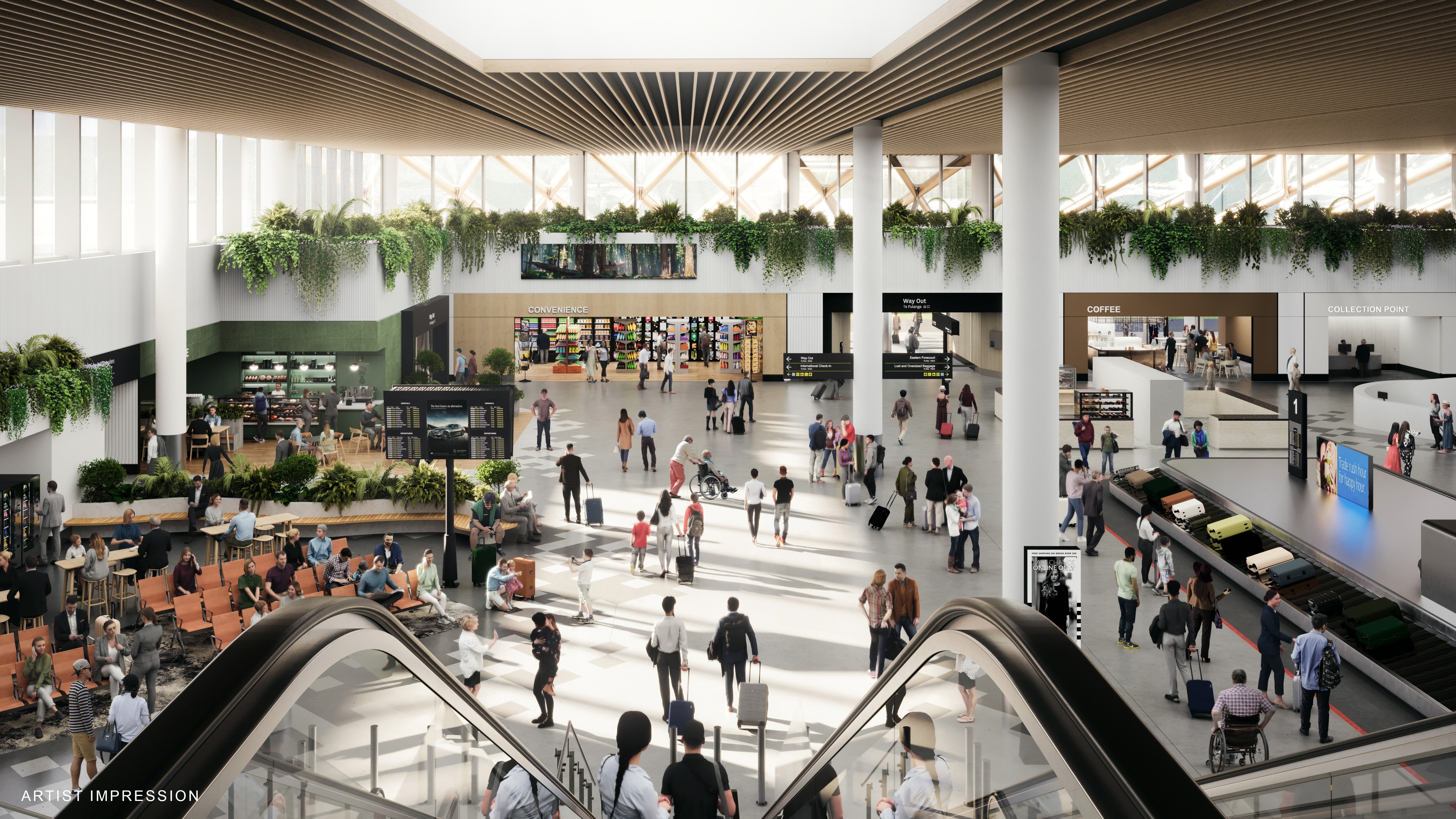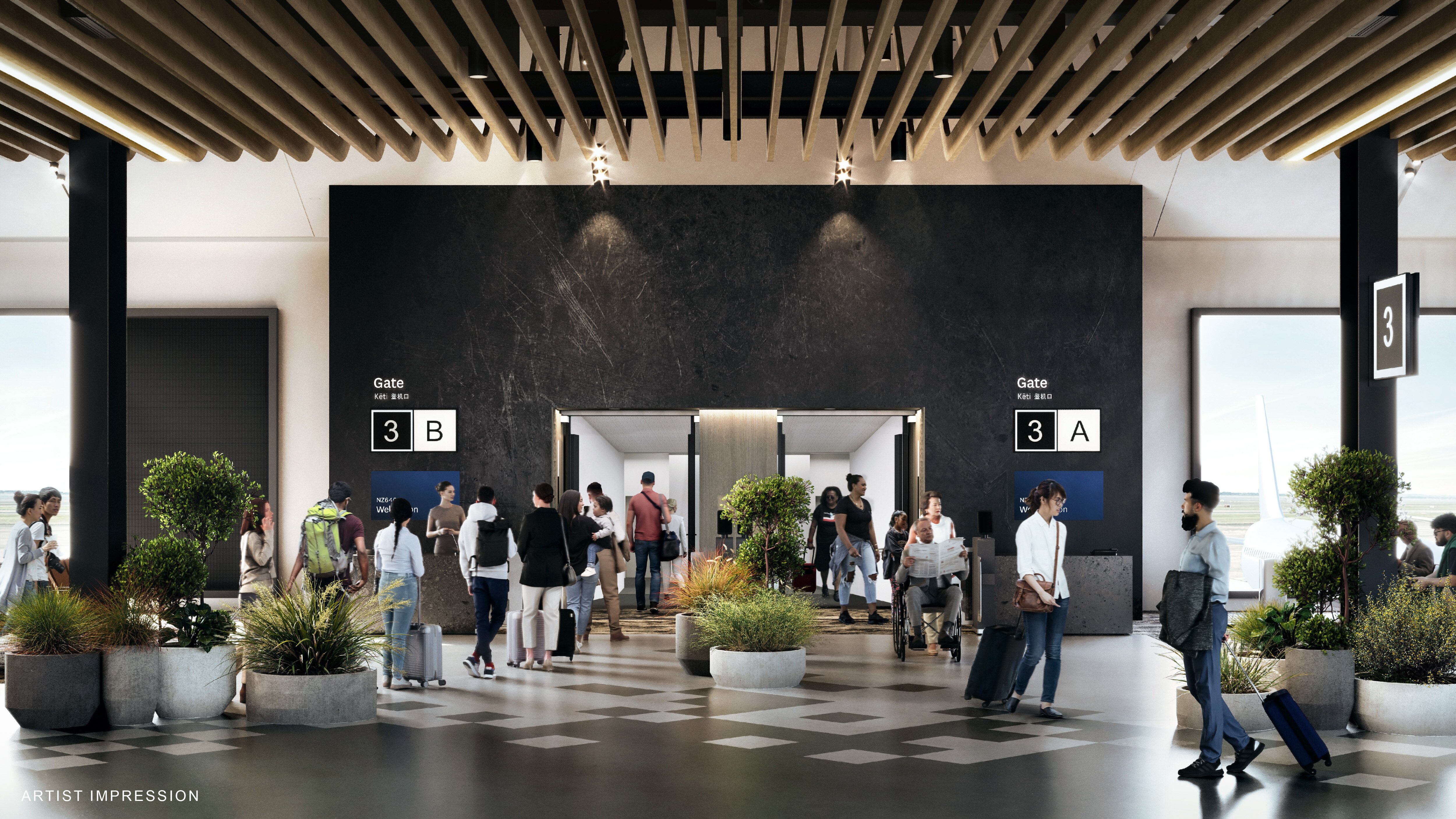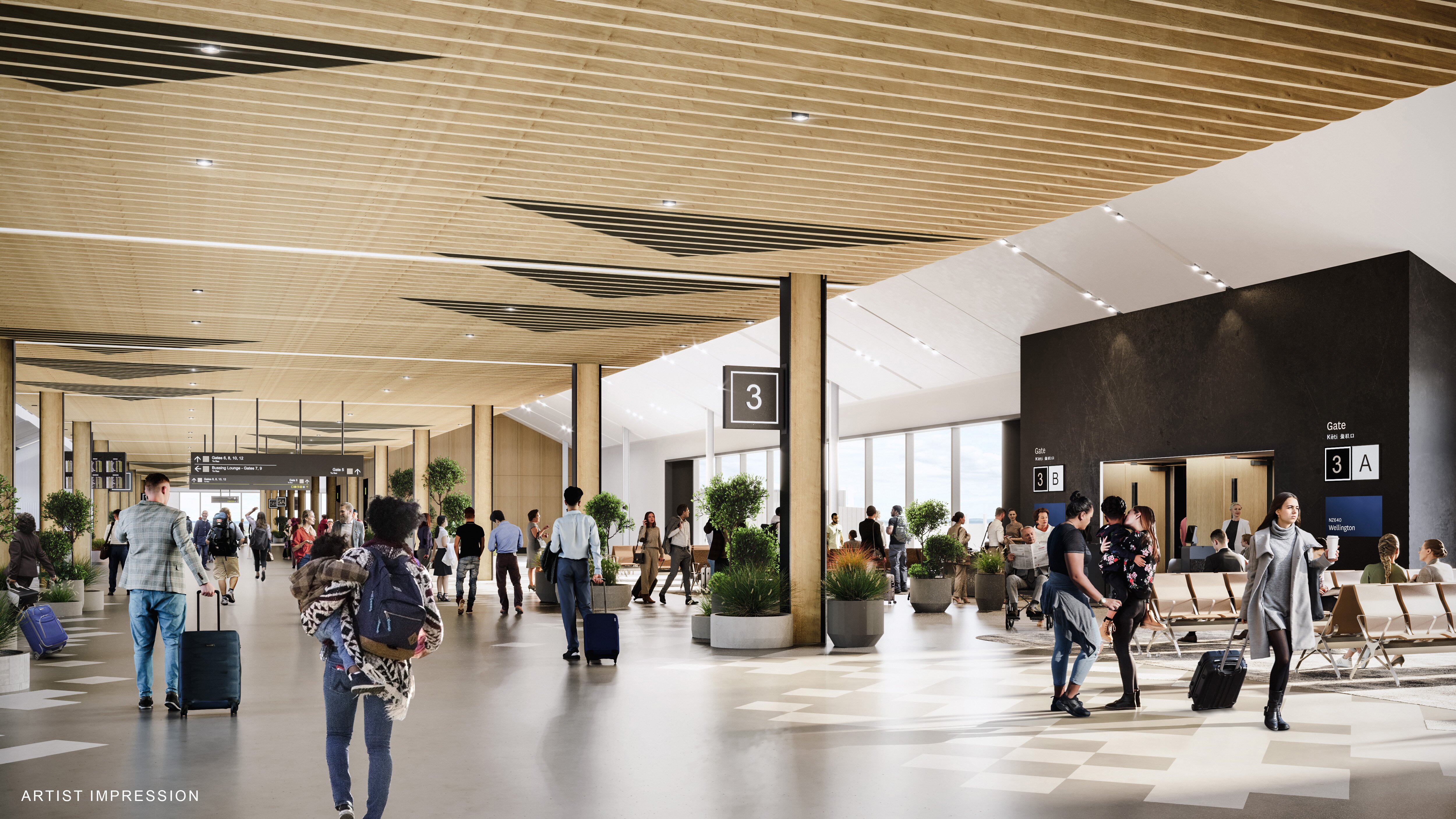
A New Welcome: Inside Auckland Airport’s Upgrade of Domestic Jet Travel
- 2024-05-02
- Doing the basics well the priority – efficient queues, a comfortable place to sit, easy to get around
- Functional, cost-efficient design, with construction materials selected for robustness and durability
- Honouring the Manukau Harbour and landscape of Tāmaki Makaurau Auckland
- One in every two seats in pre-departure dwell seating to have device charging
- Focus on bathroom facilities for families, including Changing Places™ bathroom for travellers with profound disabilities, and a low sensory space for travellers seeking a quiet setting
- Sustainability a core part of the project, targeting reduction in embodied carbon and a 30% reduction in operational emissions, against a more traditional design and build.
Auckland Airport today revealed a first detailed look at the planned interior for the city’s future new domestic jet terminal and what it will deliver for coming generations of passengers.

Expected to open at the end of this decade and taking its design cues from the Manukau Harbour and surrounding landscape, the new terminal has a simple, cost-efficient design that focuses on doing the basics really well: “Easy to get around, efficient processing, somewhere to charge your phone and a comfortable place to sit while you wait for your flight – that’s what we’re going deliver for our customers,” said Auckland Airport’s Chief Customer Officer, Scott Tasker.
“Regardless of whether you’re a frequent or occasional flyer, there’s a certain level of anxiety that comes with needing to be at the right place at the right time to catch a flight.
“It’s something we challenged ourselves to tackle in every aspect of the new domestic terminal design, from the simplicity of how travellers find their way around, to the colours and lighting we’ve chosen for key interior spaces to make it less stressful.
“It’s about bringing together fit for purpose functionality with an arrival and departure experience that uniquely reflects Tāmaki Makaurau Auckland.”
For the past three years, Auckland Airport has been working through the design for the new domestic terminal, as enabling works preparing the construction site for a successful build progress towards completion.
With detailed design near completion, the new terminal will deliver a significant uplift in customer processing, with a 44% increase in processing capacity.
“It will be an end to the blind corners, the scramble for available seating and the standing in the corridors that mark the current domestic terminal experience to something we’re proud to have visitors to our city and country to experience,” said Mr Tasker.

Designed with a simple and robust exterior structure made of tray-profile steel, Auckland Airport has concentrated its efforts on the interior of the new terminal, delivering a functional design with sustainability elements, such as all electric heating and cooling and low carbon materials.
With a single aircraft pier, the interior design employs a river-like circulation path for travellers, while off to the side soft-seating areas, complete with charging points and a clear view to flight information boards, create space to relax while people wait for their flight. The inspiration for the design has been drawn from the tidal harbour, volcanic stone fields and maunga surrounding the airport, with timber accents and a cost-effective mix of durable carpeted and rubber flooring creating a relaxed feel for travellers.
Choosing wood for the sub-floor instead of concrete, reflects a preference for low-carbon materials along with supporting sustainable aviation. The airfield around the terminal will be upgraded with electric ground power units for aircraft to plug in at gate to reduce fuel burn and a new fuel system to support sustainable aviation fuel.

A highlight for travellers will be a short five-minute indoor walk between domestic jet and international travel, meaning an end to walking the current infamous outdoor “green line” walk between terminals or taking the inter-terminal transfer bus service.
Behind the scenes, checked luggage will be tracked in real time in a modern individual carrier system (ICS) for baggage handling. For travellers starting their journey in Auckland, check-in kiosks, automatic bag drops, and all-day check-in means the end to waiting in line at check-in counters.
“All our check-ins for both domestic jet and international passengers will be in the same place, making it much easier for travellers.”
When the domestic jet terminal opens an estimated 20,000 travellers will pass through it every day, so it needs to cater to variety of people with different needs in a convenient and dignified way.
“Alongside facilities you’d expect at any airport there will be dedicated faith spaces, a low-sensory room, baby change facilities in both the male and female bathrooms, as well as a family-specific facilities, and gender-neutral bathrooms.
“We are proud to be introducing what we believe will be the first Changing Places™ bathroom for travellers with profound disabilities available at a New Zealand airport. It’s elements like these that make travel more accessible to everyone.”
Driving resiliency and efficiency
While elements of the new terminal’s design are focused on putting customers at ease, creating a terminal that is resilient and operates efficiently is key.
“We’re already considering today what we might need in two decades time through our masterplan, including how our terminal infrastructure will develop over time. A major feature of the terminal design is that it provides options to expand the main building and add in additional aircraft piers when needed.”
When complete the new domestic terminal will have in total 12 jet aircraft gates capable of handling Code C aircraft, such as an Airbus A321, with six gates able to take widebody Code E jet aircraft (with 300+ seats) by combining two narrowbody Code C jet aircraft stands.
“It’s not too dissimilar to what we have at the international terminal with Pier B gates able to handle an A380 or two narrowbody Code C aircraft. That flexibility creates capacity to manage demand surges, for example adding flights for an All Blacks game in Dunedin, and adds a 26% uplift in seat capacity overall.
“Having capacity is what makes a real difference to the traveller experience. Whether that’s enough space for pre-flight security checks, a fast, modern baggage system, technology assisting aircraft at the gates for quicker turnaround times, adequate airfield space for aircraft manoeuvring and parking, or crucially, enough aircraft gates to manage the volume of flights departing at the busiest periods of the day. That’s what keeps the system running smoothly and creates capacity for new flights to be operated by airlines which then puts downward pressure on fares,” said Mr Tasker.
The new domestic jet terminal is expected to cost $2.2 billion overall, with a further $1.7 billion to cover the cost of integrating domestic and international travel – a spend that is in line with other comparable airport upgrades around the world.
“We’ve been careful to benchmark the terminal design against other airports. Like us, airports around the world are underway upgrading infrastructure that was built to manage aircraft flying in the 1960s and 70s. This means we have some good examples to reference, including right across the Tasman where Brisbane Airport is underway with a A$5 billion programme that includes a new third terminal and existing terminal refurbishment.
“Internationally, airport standards are lifting considerably off the back of this global investment and so are traveller expectations. That will mean an increase in the charges airlines pay to use our domestic terminal facilities. In Auckland, these charges have long been at the bottom of the table compared to other major airports in New Zealand given the age of the current domestic terminal, and they will rise in line with the delivery of these much-needed improvements and the resulting lift in customer experience but at a much lower level than has been speculated.”
Currently, Auckland Airport’s airline domestic jet charges are $10.25 per passenger, moving to $15.45 by 2027 – a similar cost to what other major New Zealand airports charge today.
“We will continue to be transparent with customers and share their interest in making travel affordable for all Kiwis and supporting demand to the regions.”
With the Transport Hub nearing completion and the closure of the drop off and pick up area directly in front of the international terminal, construction work on the new domestic terminal will start later this year.
Auckland Airport continues to consult with airlines on the future of regional travel as investing in terminal and airfield infrastructure to create appropriate turboprop capacity and customer experience for those travelling to regional New Zealand is key to the airport’s masterplan.
FAST FACTS
- $2.2 billion for new domestic terminal overall. Additional integration costs are $1.7 billion
- New terminal to service jet aircraft – the larger aircraft that fly between Auckland and other main centres.
- 12 jet aircraft gates create 26% more seat capacity, with a further 10% seat capacity available with dedicated domestic bus lounges
- Transfer between domestic jet and international flights within the terminal
- Check-in kiosks and automatic bag drops, capable of future upgrades to biometric technology, to speed up check-in process
- In line with IATA best practice: queue wait times of 4 minutes or less for self-check-in and to drop a bag, less than 7.5 minutes for security, adequate seating at boarding gates, timely baggage arrival with <15 minutes from first bag to last bag on belt
- Device charging points in 50% of seats in pre-departure dwell
- Two baggage reclaims with 180m of belt space – a 70% increase on the current domestic terminal
- Dedicated faith spaces plus a low sensory room provided for travellers
- Changing Places™ bathroom equipped with special features to meet the needs of travellers with profound disabilities who cannot use standard accessible toilets, alongside generous bathrooms for families, as well as gender neutral and accessible bathrooms.
- Integrated terminal to be completed in 2028/2029.
PRICING
- Airports operate under a regulated, user-pays system in which airlines pay to use the core infrastructure – runway, taxiways, and terminal areas they need to operate their business
- Airport charges, which are set every five years after consultation with airlines and are reviewed by the Commerce Commission, make up a very small percentage (less than 5%) of an airfare
- Auckland Airport’s domestic charges have been consistently 40-50% lower than other comparable airports, but will rise as airlines begin using new infrastructure
- Auckland Airport’s airline domestic jet charges are $10.25 per passenger, moving to $15.45 by 2027 – a similar cost to what other major New Zealand airports charge today
- Airline charges for Price Setting Event 4 (PSE4) are currently being reviewed by the Commerce Commission in a transparent process aimed at ensuring the charges are reasonable and allow the recovery of costs of appropriate airport infrastructure investment to improve the customer experience.







